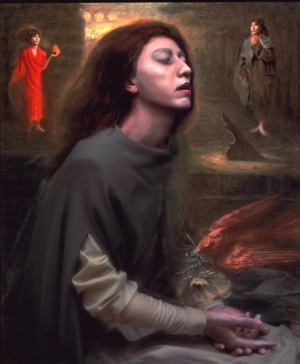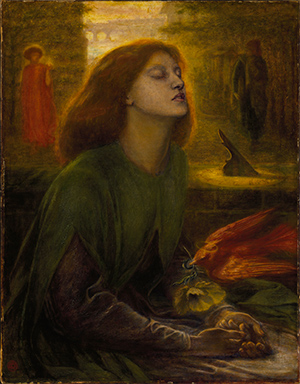Artistic Inspirations
Yasumasa Morimura
Yasumasa Morimura
Japanese, born 1951
Portrait (Poppy), 1991
Color photograph mounted on canvas
55 1/4 x 47 1/4 inches (140.3 x 120 cm)
Courtesy of Cristinerose Gallery, New York
© Yasumasa Morimura; Courtesy of the artist and Luhring Augustine, New York. (1 image)
Reimagining Pre-Raphaelite painter Dante Gabriel Rossetti’s famous painting in London (Fig. 1), Yasumasa Morimura reworks Rossetti’s depiction of the love story between Dante and his departed beloved Beatrice. Morimura accomplishes this by transforming and inserting himself into the scene with the aid of makeup, props, costumes, and digital manipulation.
In Rossetti’s original painting, auburn-haired Beatrice occupies the foreground, not yet dead, but in a moment which Rossetti wrote of as a “sudden spiritual transfiguration”.[1] A haloed red dove descends upon her left arm holding a poppy—an ancient symbol of sleep and death. In the middle ground, a sundial rests atop a stone wall with its shadow pointing to nine o’clock, the time of Beatrice’s death on the 9th of June, 1290. In the background stand the poet Dante and the figure of Love; Dante gazes across to Love, who holds his flaming heart.
Fig. 1: Dante Gabriel Rossetti, Beata Beatrix, ca. 1864–70, Tate Britain, London (1 image)
The treatment of Self-Portrait (Poppy) reflects some of the core themes of Morimura’s artistic journey—namely, his notorious manipulation of both gender and culture. While this piece retains many core elements of Beata Beatrix, it both plays with classic portrayals of the male and female and also challenges the cultural conventions of beauty outside of traditional western ideas.
Morimura flips the common gendering of the classic artist-and-muse juxtaposition as he inserts himself into the scene as Beatrice, while also replacing Love and Dante with two new feminine figures in the background. Love—who is both described in Dante’s poem Vita Nuova and depicted in Rosetti’s Beata Beatrix as a man—is now seen as a woman, wearing a bright red kimono-style dress. The new Dante is similarly portrayed in an effeminized manner, with long curly brown locks framing their face instead of the poet’s classic red cap.
Additionally, Morimura expands what the character of Beatrice represents as an archetype of beauty and perfection. When Dante described her in Vita Nuova, she was a “fair woman” with the “paleness of a pearl”, much in the fashion of a courtly love description of a thirteenth-century Italian woman; Rossetti similarly modeled his Beatrice after his own wife, Elizabeth Siddal, a nineteenth-century British woman and a paragon of western beauty, herself. Morimura, instead, embodies this Beatrice portrait as a Japanese man, challenging the traditional western limits applied to the concept of beauty, for which she is a prime archetype.
Morimura’s reimagining of this work also reflects his desire to refocus the story of Beatrice with a new focus. While Rossetti chose to emphasize Beatrice’s beauty in her spiritual transformation in Beata Beatrix, Morimura’s piece—even down to his retitling it as Self Portrait (Poppy)—brings into focus elements that instead emphasize the weight of Beatrice’s death. Rossetti saw an analogue between his approach and that of Dante’s as an artist: Rossetti’s love for Elizabeth drove him to paint just as Dante’s love for Beatrice drove him to write. Morimura’s approach changes the narrative: he becomes both the artist and the muse. Where Rossetti and Dante became enamored by the beauty of their departing love, Morimura here memorializes the tragedy of her death in this moment before it arrives.
Hannah Master ’23, Nancy Horton Bartels ‘48 Scholar, Summer 2021
Footnotes
[1] Andrew Wilton and Robert Upstone (eds), The Age of Rossetti, Burne-Jones & Watts: Symbolism in Britain 1860-1910, exhibition catalogue, Tate Gallery, London 1997, 86. ↩

